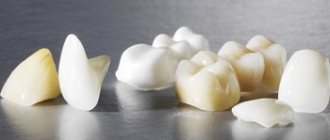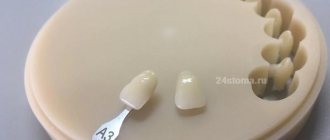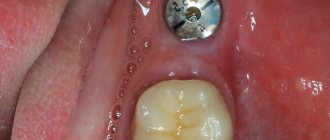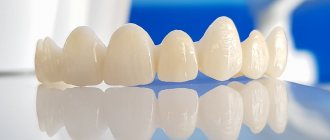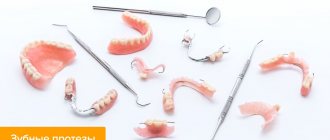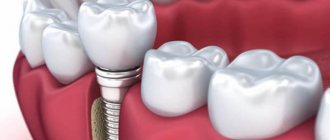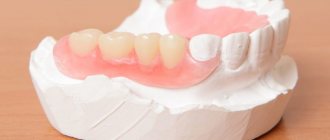Temporary dental crowns are crowns made from inexpensive materials that are used during prosthetics only to protect teeth until permanent crowns are installed.
The purpose of using temporary crowns is to strengthen teeth and give them a natural appearance.
Such crowns are not very stable and have limited aesthetics. They are installed on a previously ground tooth or on an implant.
In what cases are temporary crowns installed?
- When a tooth is chipped or completely lost.
- After root canal treatment.
- In the case where caries has led to weakening and destruction of the tooth crown.
- After implantation.
Rules for wearing, care and adaptation
Temporary prosthetics are created very quickly and are not highly accurate, and naturally, the patient may feel some discomfort after its installation. Most often, such a prosthesis will interfere a little when closing the jaws. It is recommended that you tell your doctor about all the inconveniences, who will make adjustments and make it more comfortable and convenient.
Since temporary cement is used for fixation, the provisional prosthesis is not very securely fixed in the oral cavity. Therefore, to protect it (and the tooth itself), some precautions should be taken:
- avoid eating “stretchy” foods: toffees, chewing gum, etc.,
- reduce the chewing load on the temporary prosthesis: it is better to chew food on the opposite side,
- avoid eating solid foods
- Carry out hygiene procedures with caution: use threads especially carefully. An irrigator that gently and efficiently removes pieces of food from the interdental spaces will be a good help.
Why are temporary crowns needed?
Before installing a permanent crown on a tooth, you must wait until the mucous membrane has healed. To protect the oral cavity from bacterial infections during this time, temporary crowns were created.
The dentist places a crown, which is bonded to the tooth with special temporary cement so that it can be easily removed when the final crown is ready.
Why is it necessary to put a temporary crown on your teeth?
- A temporary crown protects the ground tooth and ensures patient comfort while ensuring proper aesthetics.
- Preserving the aesthetics of a smile. Temporary crowns are especially often used to cover missing front teeth.
- Protection against hypersensitivity. A ground tooth without enamel protection is sensitive to the pain of temperature changes.
- Bite stabilization. A temporary crown prevents the remaining teeth from shifting.
- Protection of periodontal tissues. A temporary crown is necessary to prevent gingivitis.
- Protection against bacteria arising in the oral cavity.
Price list for orthopedic treatment
| Name of service | Price |
| Solid metal crown Crowns are made from cobalt-chrome, nickel-chrome and titanium alloys. They are durable and good for restoring the chewing function of teeth, but do not restore aesthetics. Find out which crowns are not only durable, but also aesthetic | 10000 ₽ |
| Metal-ceramic crown Crowns consist of a cast metal base and a ceramic layer applied to the metal. Metal-ceramic crowns combine the strength of metal and the aesthetics of ceramics. Learn about the pros and cons of metal-ceramic restorations | from 16500 ₽ |
| Metal-ceramic crown on an implant | from 42000 ₽ |
| Zirconium dioxide crown Ceramic-veneered zirconium dioxide crowns are both durable and beautiful. Modern materials and technologies for the production of dental crowns make it possible to abandon the choice between “Reliability” and “Beauty”. Find out what it means to choose a crown without compromise | 38500 ₽ |
| Veneer Installing veneers on your front teeth is a sure way to a flawless smile. Veneers remove the space between teeth, change the color of darkened teeth, correct the position and shape of teeth, and cover fillings and chips. If you only agree to impeccable aesthetics in the “smile zone,” choose ceramic veneers. | 27500 ₽ |
| Permanent fixation of the crown | 1000 ₽ |
| Taking an impression | 1600 ₽ |
| Temporary crown The Dental Association of Russia (STAR) recommends the use of temporary dentures as a cosmetic and functional guideline for the manufacture of permanent denture structures. What else do you need to know about temporary crowns? | 2100 — 6500 ₽ |
| Stump tab | 7000 — 8000 ₽ |
| Removable acrylic prosthesis IVOCAP | 45000 ₽ |
| Clasp prosthesis | from 48000 ₽ |
| Flexible removable denture Acry Free Whatever opportunities modern dental implantation provides, there are patients who, for various reasons, cannot take advantage of this prosthetic technology. The Acryfree® material developed by the Israeli company Perflex makes it possible to produce aesthetic removable dentures that are completely biocompatible and do not contain components that cause allergic reactions. | from 42000 ₽ |
Installation of a temporary crown
The placement of a temporary crown is usually completed in one visit to the dental office. The installation process takes about 10-30 minutes. The procedure is painless. Grinding and correction of teeth are performed under local anesthesia.
First, the dentist prepares the tooth for a permanent crown. The tooth surface is ground down approximately 1-2 mm on each side.
Impressions of the teeth are then created. They are sent to a dental prosthetics laboratory, where permanent crowns are created.
While they are being made, the patient is given a temporary plastic crown. Once the dentist has received the finished permanent crown, he places it on the patient's tooth.
During the first days after the procedure, the patient may feel discomfort because the shape of the tooth with a temporary crown may be slightly different from what it was before.
Possible complications and side effects after the procedure:
- Discomfort
- Tooth sensitivity
- Allergic reaction
The main functions of such prostheses:
- protection of the pulp from the negative influence of pathogenic microorganisms;
- preventing displacement of treated and adjacent teeth;
- formation of the gingival margin and prevention of gum growth when treating teeth with a special ledge;
- reconstruction of occlusion during therapy for increased wear of chewing elements;
- continuation of the full functionality of teeth;
- acceleration of adaptation to the modernized chewing element, which will take the place of the affected one after installation;
- maintaining the aesthetic appearance of the oral cavity.
Many people are concerned about the question: how long can temporary crowns be worn? The answer is simple - the entire period allocated for the manufacture of permanent dentures.
This may even take a couple of months. When these orthodontic structures are worn for a long time, they wear out, which will lead to the displacement of adjacent teeth.
Inflammation of the gingival margin also occurs due to bacterial contamination of the plastic. Sometimes the crown breaks, followed by gum growth and pain.
The production of such crowns is much faster than their permanent counterparts.
Regardless of what material modern crowns are made from, they are fixed with temporary cement. Such material gradually dissolves under the influence of saliva.
Sometimes it becomes necessary to attach temporary dentures after implantation. This is because it is important for the gums to return to the desired shape after this type of intervention, and non-permanent crowns can help with this.
Before installing a permanent prosthesis, the implant must take root. The average period of its integration in the upper jaw is about six months, and in the lower jaw – 4 months.
The lower jaw is better supplied with blood, and it is larger and stronger, since it bears more chewing load.
While it takes root, the patient wears a temporary crown, which imitates a regular tooth, protecting the gums from inflammation.
Dentures are placed on an implant when the dental nerve is removed and it is not possible to restore the chewing element.
Tips for using temporary crowns
- Some foods will stick to the temporary crown, so please avoid chewing gum or other sweets and foods.
- Avoid chewing on the side of your jaw where the temporary crown was placed.
- Try to minimize your consumption of hard foods (such as vegetables), which can break the crown.
- Temporary crowns do not last long. Sometimes they may crack, break or fall out. If this happens to you, please contact us immediately, bring the crown with you, we will reinstall it or replace it.
- Do not remove the temporary crown from your mouth. Without it, your teeth may shift and the target crown may not fit.
- Don't brush too hard on a tooth with a temporary crown, and be careful with floss.
How to make
There are two methods for making temporary crowns: direct and indirect. The production method largely depends on the indications and wishes of the patient. The indirect method is much more expensive, but this crown is stronger and lasts longer.
Direct manufacturing steps:
- taking an impression of the jaw;
- preparation and grinding of the natural crown and possibly adjacent teeth;
- casting a product from a material according to a cast;
- installation and adjustment of the crown;
- fixing the product with cement.
This method is recommended by dentists if treatment is not planned and it is necessary to protect the tooth from external factors and stress.
The entire procedure takes about two hours.
What is the function of glue?
After examination and during the process of grinding the tooth, the orthopedist decides which crown is best to install: removable or permanent, restorative or supporting. The patient is also asked to choose a construction material; it can be metal, metal-ceramics, plastic, or a combined composition.
To fix a permanent structure, a long-term and durable cementing agent is required. It tightly, hermetically holds the prosthesis in place.
Removable crowns require more troublesome care and the patient requires temporary cement to hold them on the tooth surface. You can purchase a similar adhesive composition in the pharmacy department; the cost of the product varies from 140 to 400 rubles.
There are several types of glue that not only hold crowns and dentures in place, but also have additional effects:
- retain moisture without absorbing it (a similar product is recommended for patients with increased salivation);
- do not allow pathogenic bacteria to pass through;
- make your breath fresh - if the glue contains flavoring additives.
The fixed structure is fixed once, so composite cement is used, which provides a rigid connection for a long period. Regardless of the crown material, they are attached to the same fastening compound.
Kinds
To select adhesive for crowns, you can consult your dentist. However, in this matter, the individual characteristics of the body play an important role, so even taking into account the recommendations, you may need to try several different options and settle on the most suitable one.
What to do if a tooth has rotted under the crown
There are three types of product available, which differ in consistency:
- viscous;
- medium viscosity
- liquid.
The last type of glue consumes more than others, but it is most often chosen by people who have recently undergone the procedure of installing dental crowns. This is due to its ease of use. However, gradually, a person adapts to more viscous compositions, as they dry faster.
Any prosthesis, even a small one, causes discomfort in a person; in addition, it is capable of changing taste perception at first. To shorten the period of adaptation, it is not recommended to immediately use products that contain fragrances.
Advantages and disadvantages of cement fixation
Positive points:
- There is no need to prepare an access hole. This provides better aesthetic results. The use of a cement composition for prosthetics of the frontal sections is especially justified.
- Superstructure fit correction. If implantation is carried out carelessly, cement fastening allows you to smooth out all existing flaws. Due to this, it becomes possible to perform prosthetics even with a non-optimal position of the implant.
- Primary fitting can be carried out outside the oral cavity, which increases the accuracy of attachment and eliminates inflammation.
- Lower level of weakening of the adhesion of the abutment to the implant in the long term (compared to the screw type of fastening).
- Better quality of biological functioning.
- Ease of manufacture and installation. If the implant axes diverge by more than 17 degrees, restoration with cement fastening is much easier. The technique is in many ways similar to how bridges are installed.
- No passive fit required compared to screw mounting.
- Tools and materials are cheaper.
Opinion of an orthopedic dentist : “I have been working with cement fixation for many years. This is a simple, economical method. Of course, there is a risk of being unable to control the complete cleaning of the subgingival space from excess cement. It is therefore important to follow basic guidelines regarding the level of immersion of the crown/abutment interface. With cement fastening, this figure should not exceed 0.5 mm.”
The main disadvantage is the difficulty of removing the crown, which means that later, if it is necessary to replace structural elements, you will have to make a new prosthesis. Other reasons that make dentists refuse to use:
- Precision fit cannot be achieved due to the fitting of the prosthesis under hydrostatic pressure alone.
- There is a high risk of excess glue getting deep into adjacent tissues, which can cause serious complications, including peri-implantitis. Remaining cement is difficult to clean.
- In the case of an inaccurate fit between the crown frame and the abutment, saliva may wash out the adhesive over time. Plaque and bacteria will begin to fill the resulting space.
- Low predictability of connecting metal elements compared to the screw fastening method.
Three ways to attach crowns or dentures during implantation
- Cement - attachment to the abutment is performed using composite glue. It has good shock-absorbing properties. The most common type of fixation, which simplifies the installation of a bridge consisting of several elements.
- Screw - the crown is secured to the abutment outside the oral cavity. The resulting structure must be screwed into the implant. A technological hole is used through which a screw is screwed. To disguise it, a composite material is used.
- Telescopic - involves the use of double crowns: one is fixed to the abutment, the other is mounted into the body of the prosthesis.
Manufacturing and installation
Temporary crowns can be made using one of two methods:
The direct method allows you to make a provisional structure in about one hour
Using a softened silicone mass, the dentist makes impressions, after which the tooth is ground down. The doctor pours plastic into the impression and places it on the prepared, ground tooth. After this, the impression is removed, and the hardened plastic product remains in place.
The specialist grinds off excess material from the product, and then polishes and grinds it. The finished product is fixed with dental cement.
The indirect method involves manufacturing the product in the laboratory
Impressions are taken using silicone paste. Two models are made from plaster. A temporary structure is then created using wax. Crowns made by the indirect method are stronger and more reliable, and also best suit the anatomical features of the patient’s jaw. How to organize care?
Since dental restorations are attached with temporary cement, avoid sticky or viscous products that can damage or detach the material from the tooth. In addition, experts recommend reducing the load during chewing on the area of the jaw where the crown is installed.
When brushing your teeth, handle the temporary product carefully to avoid damaging it. Please note that such structures can only be used until a permanent prosthesis is installed. What to do if the temporary product falls out? It is necessary to contact a specialist for re-fixation with temporary cement. At night, it is better to remove the unglued crown from the oral cavity and place it in a glass of water.
Author of the material: Semenova Anna.
Features of cement fixation
Before cementing, it is necessary to take an x-ray and carefully remove any remaining temporary dental adhesive. Cementing makes it possible to circumvent a number of limitations of the screw type of fastening:
- low occlusal stability;
- difficulty in manufacturing restorations with passive fitting.
There are also other features:
- soft tissues are mainly supported by the abutment;
- the crown is seated in such a way that its edge is at the same level or slightly apical to the gingival margin.
Materials
Synthetic polymethyl methacrylate is used for production. It is suitable for long-term wearing, making bridges and single-piece appliances. At the same time, production requires minimal time, the design is strong and reliable. No complex equipment is required; with the direct method, all actions require a minimum of time, that is, production occurs in one step.
Features of the material include the following properties:
- natural look, shine, surface polishing to give naturalness;
- biological compatibility;
- the cost of the design is affordable;
- increased aesthetics, the ability to restore the exact shape of a lost unit.
